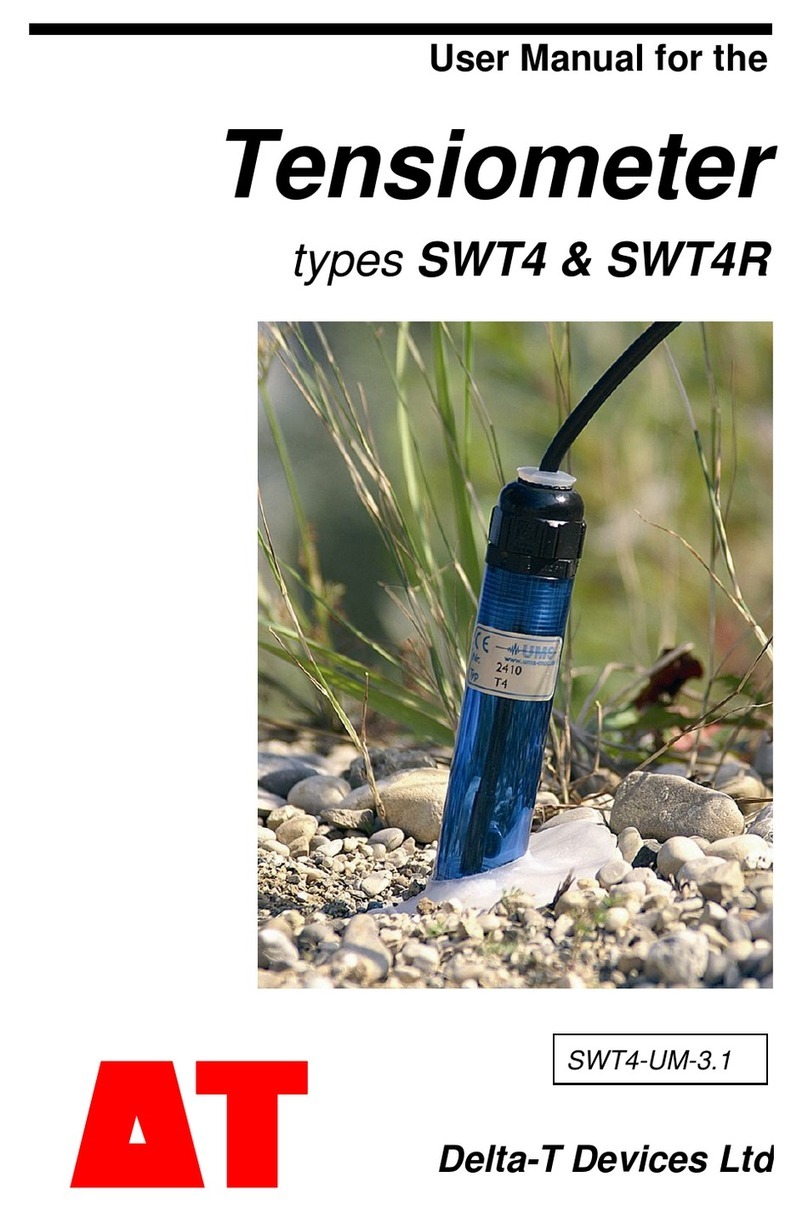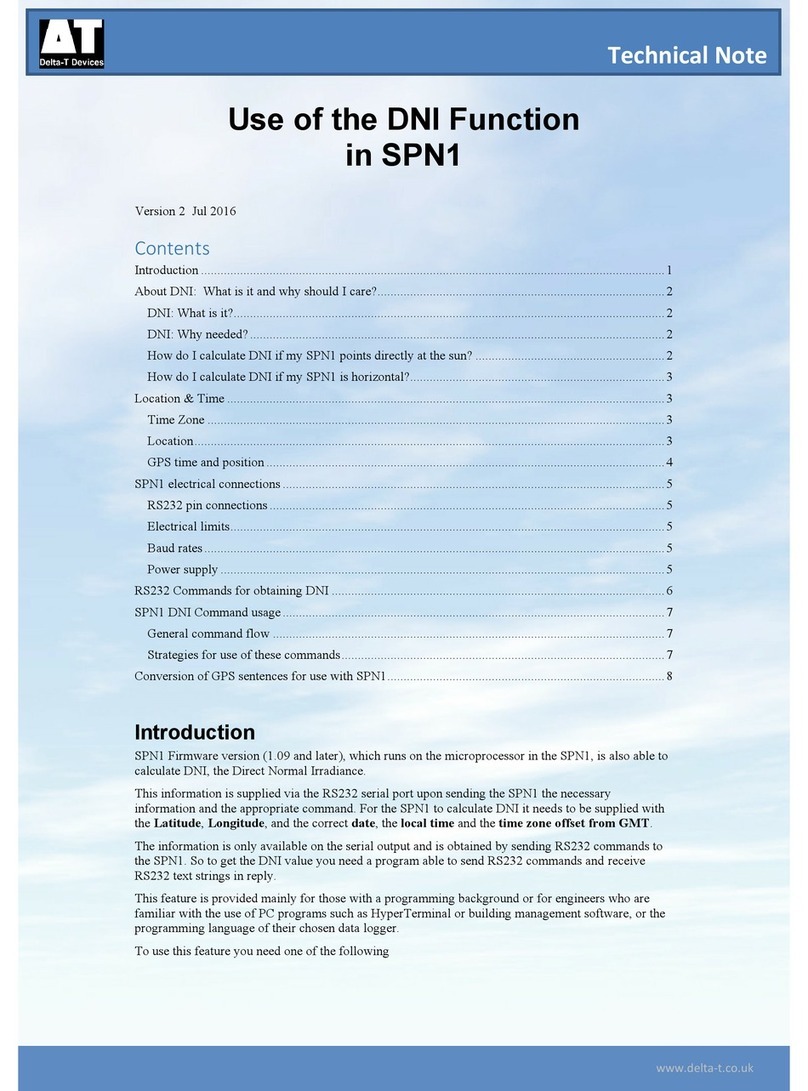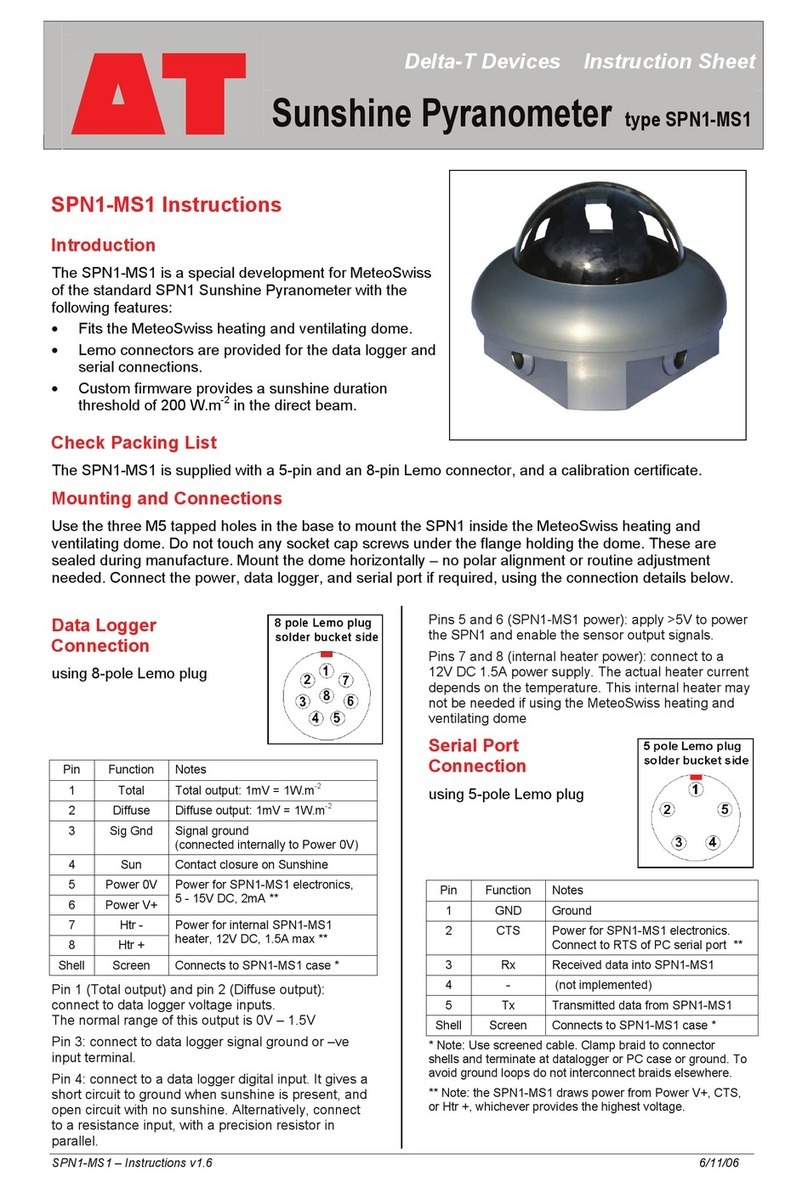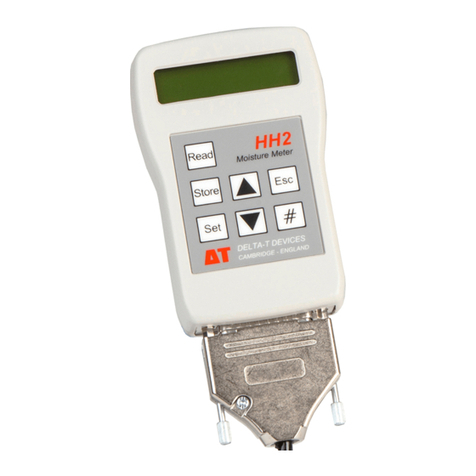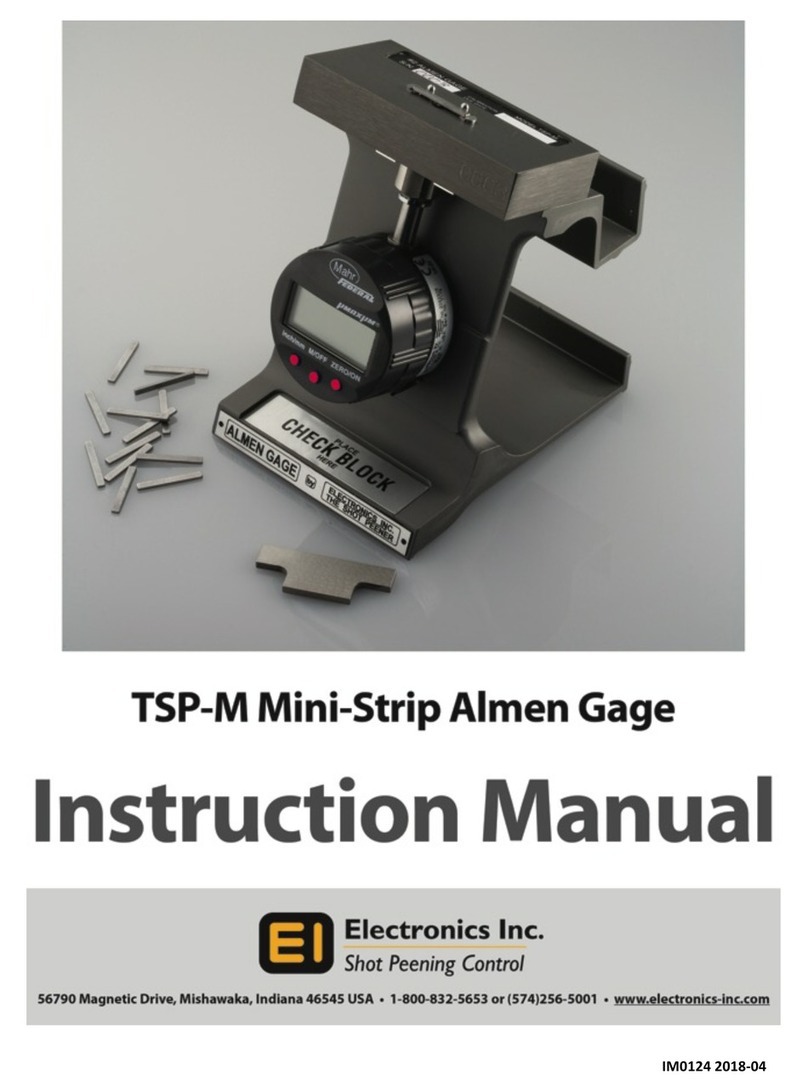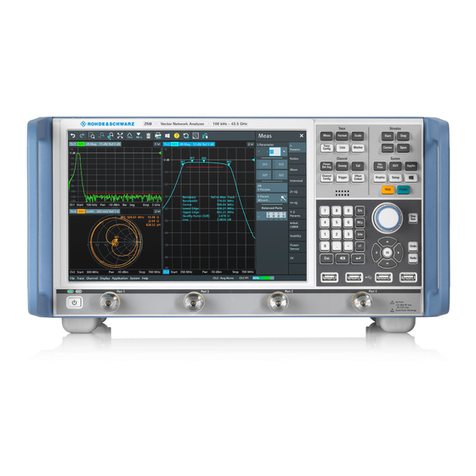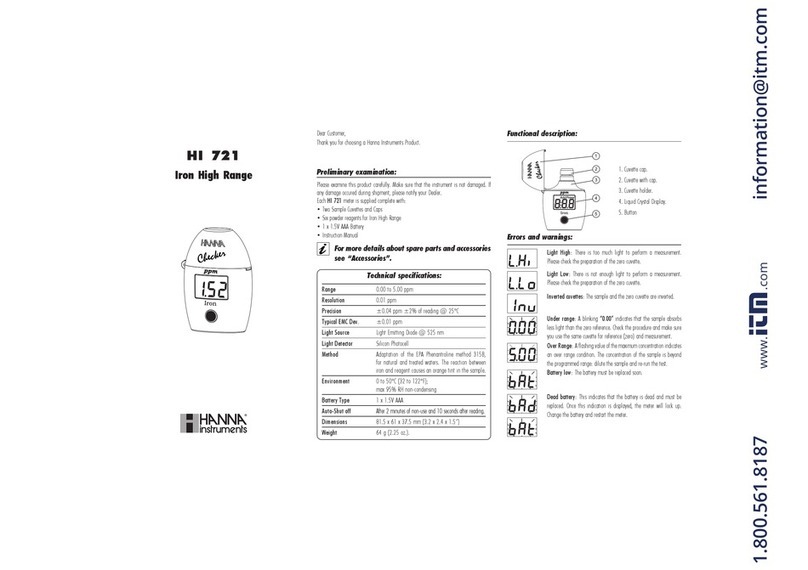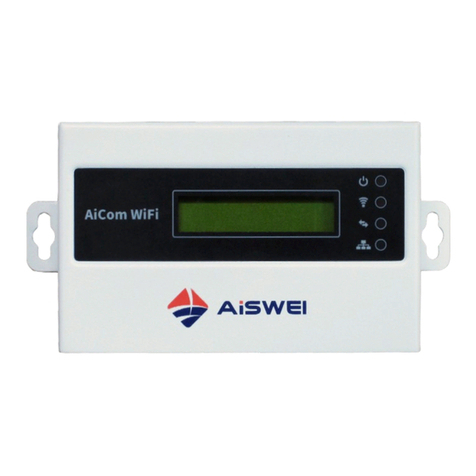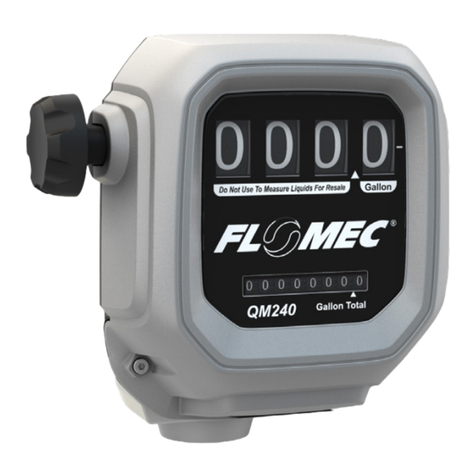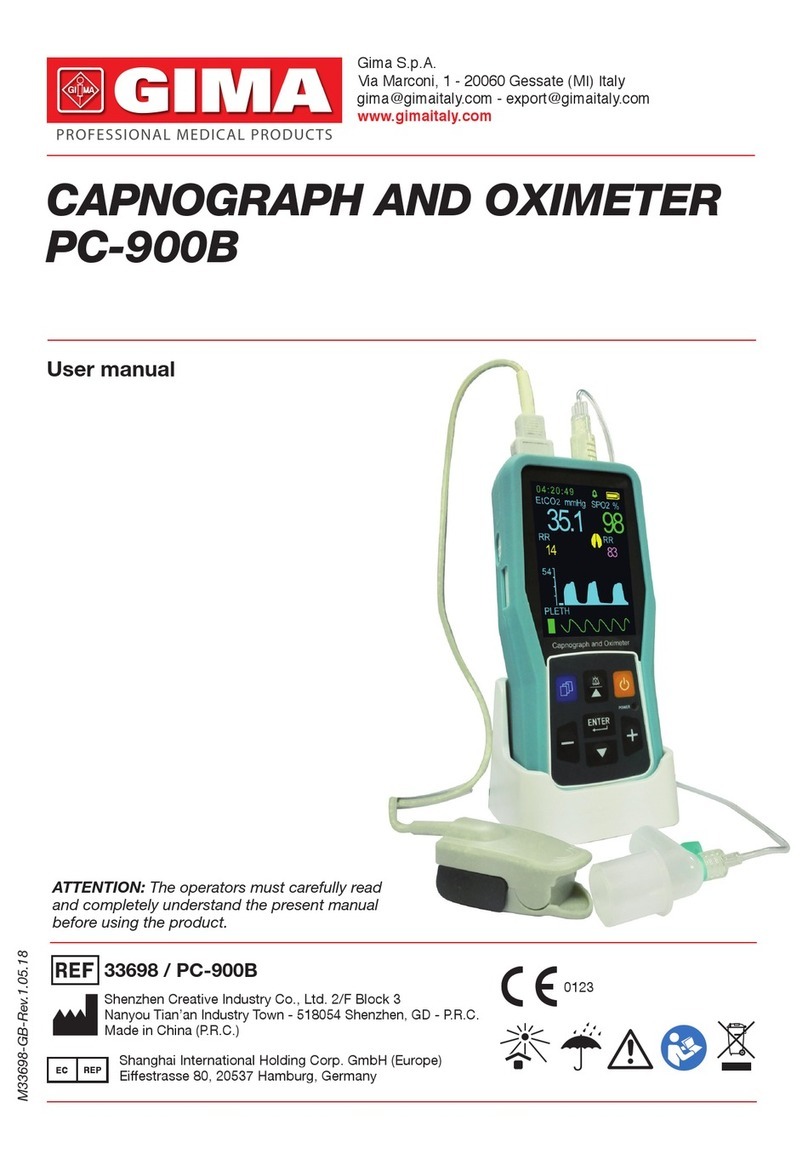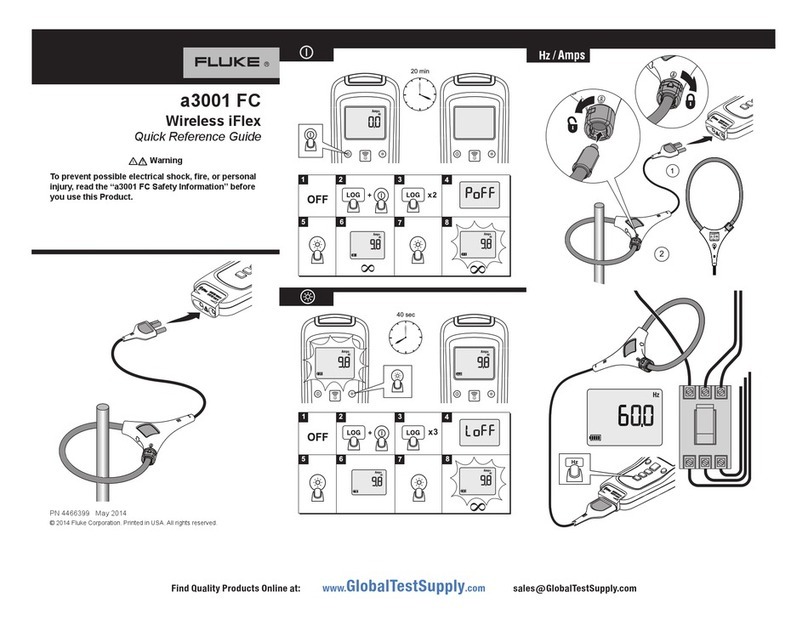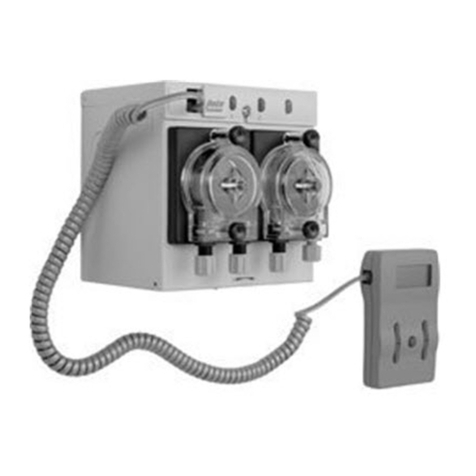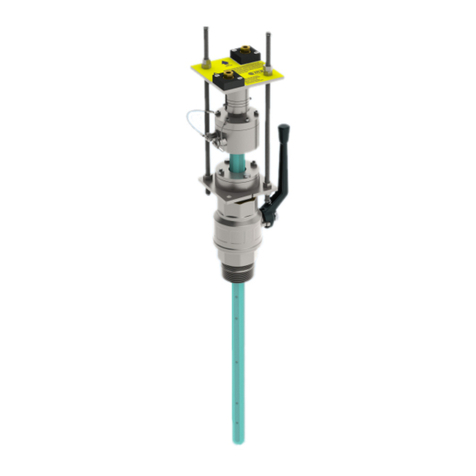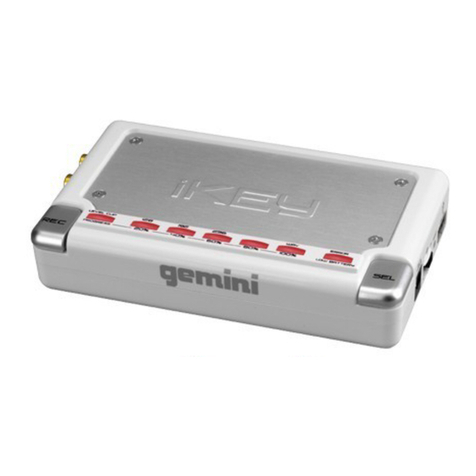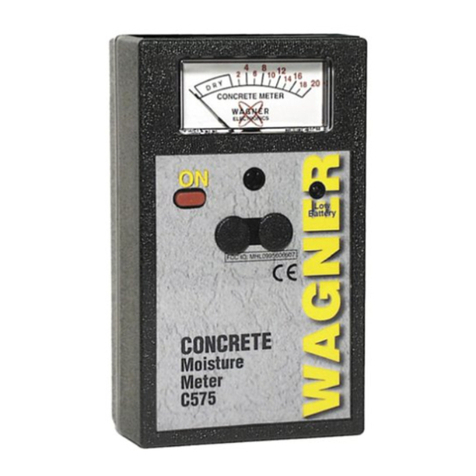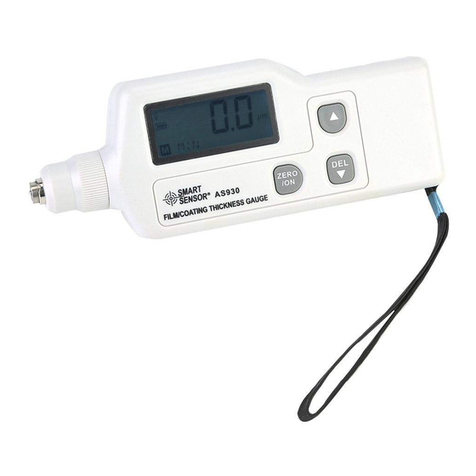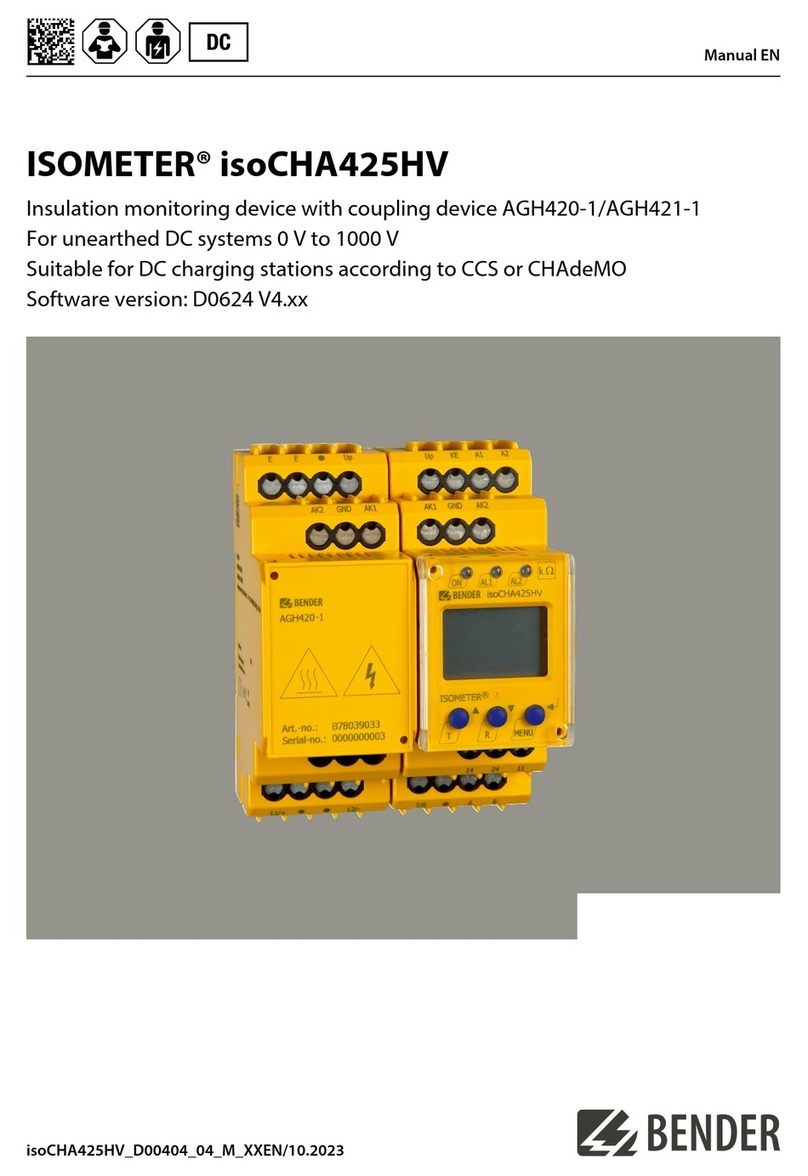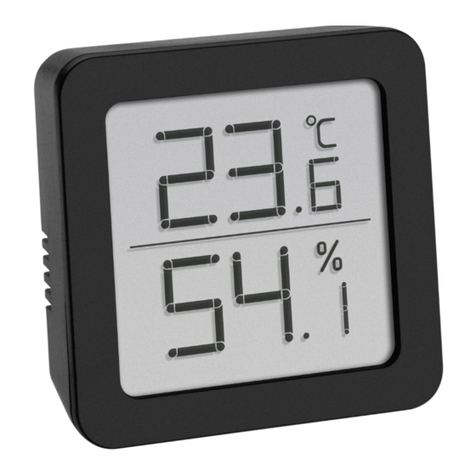Delta-T SPN1 User manual

User Manual for the
Sunshine
Pyranometer
type SPN1
SPN1-UM-1.0
Delta-T Devices Ltd

Notices
Copyright
All rights reserved. Under the copyright laws, this manual may not be
copied, in whole or in part, without the written consent of Delta-T Devices
Ltd. Under the law, copying includes translation into another language.
Copyright © 2007 Delta-T Devices Limited
SPN1 Sunshine Pyranometer optics design and theory are copyright ©
1996 John Wood, Peak Design Ltd, Winster, Derbyshire, U.K. and
protected by Patent No. EP1012633 & US6417500.
Trademarks
Windows is a registered trademark of Microsoft Corporation.
All other trademarks are acknowledged. Some names referred to are
registered trademarks.
CE Conformity
The SPN1 Sunshine Pyranometer conforms to EU regulations regarding
electromagnetic emissions and susceptibility and is CE marked by
Delta-T Devices Ltd.
Warnings
To maintain conformance to CE standards, the equipment must be used
as described in this manual. Modifications to the equipment may
invalidate CE certifications.
Delta-T Devices Ltd reserves the right to change the designs and
specifications of its products at any time without prior notice.
Author
John Wood.
User Manual Version: 1.0 June 2007
Delta-T Devices Ltd
130 Low Road, Burwell
Cambridge CB25 0EJ
UK
Tel:+44 (0)1638 742922
Fax:+44 (0)1638 743155
email:[email protected]
web:www.delta-t.co.uk

Contents
Introduction 4
About this manual 4
Description and functions 4
Construction 6
Accessories 7
System overview 8
Power considerations 9
Use with a data logger 11
Delta-T data logger connections 18
Use with a PC or serial device 19
Accuracy and errors 20
Technical reference 21
Specifications 21
SPN1 spectral response 23
SPN1 cosine response 24
Routine maintenance 25
Calibration procedure and traceability 27
Warranty and service 29
Terms and conditions of sale 29
Service and spares 30
Technical support 30
Problems 31
Troubleshooting 31
Appendix A: Design and test summary 32
Introduction 32
Design objectives 32
How the design evolved 32
Calculation of outputs 33
Test results 34
Appendix B: RS232 commands 37
Operating modes and serial commands 37
Glossary 41
SPN1 User Manual v1.0 z3

Introduction
About this manual
This manual,describes the SPN1 Sunshine Pyranometer and how to use
it. See also the SPN1 Quick Start Guide.
Appendix 1 describes the SPN1 design and includes a summary of the
test results of several experimental trials of the SPN1.
The Delta-T Software and Manuals CD contains document files in Acrobat
pdf format, and software. It includes this manual, the SPN1 Quick Start
Guide, and other files relating to the SPN1. The CD also contains the
SunRead software.
Description and functions
What it measures
•The SPN1 Sunshine Pyranometer is one sensor with three output
channels:-
1. Total (global) solar radiation
2. Diffuse radiation
3. Sunshine status.
•The SPN1 measures short wave radiation between 400nm and
2700nm in W.m-2.
•The Direct beam component of solar radiation can be calculated from
the Total minus the Diffuse component.
•The Sunshine status output indicates whether the energy in the direct
beam exceeds the WMO standard threshold value of 120 W.m-2,
using an algorithm based on the Total radiation, and the ratio of Total
to Diffuse radiation.
•The radiation outputs have a cosine-corrected response.
What it is used for
•Meteorological Global, Direct and Diffuse solar radiation and sunshine
duration measurements.
•Solar energy monitoring, and solar collector studies.
4 zIntroduction SPN1 User Manual v1.0

•Architecture and building design, illumination and heat balance
studies of buildings.
Advantages of SPN1
•It matches the WMO ‘Good Quality’ pyranometer classification.
•It requires no shadow band or solar tracker.
•There are no moving parts.
•It does not need to be adjusted or repositioned to track the sun – a
distinct advantage over shade rings or mechanical trackers.
•It does not need to be oriented towards North. It will work accurately
in any orientation as long as it is mounted horizontally.
•It does not require knowledge of the Latitude or Longitude, and can
be used at any Latitude or Longitude.
•It measures sunshine hours as well as Total and Diffuse radiation.
•The built-in heater allows use in wet or icy conditions.
SunRead PC software
•The Delta-T Software and manuals CD contains SunRead Windows
PC software that will read the SPN1 output values and status
information via the PC RS232 serial port.
•SunRead also provides a basic logging capability while the SPN1 is
connected to the PC.
Use with data logger
•The three outputs of the SPN1 can be logged with a suitable data
logger. The Total and Diffuse radiation millivolt outputs require two
analogue channels.
•The sunshine state logic output can be taken to a digital channel, or
for some purposes can be connected to an analogue channel in order
to give readings of sunshine duration.
•The SPN1 is a powered sensor, and requires a power supply of 2mA
at 5V – 15V, from the datalogger, the heater supply, or elsewhere.
•The SPN1 heater requires a permanent power supply of 12V – 15V at
up to 1.5A.
Use via serial port
•The SPN1 can be interrogated from any serial port program (eg
Windows Hyper Terminal) - see Appendix B: RS232 commands.
SPN1 User Manual v1.0 Introduction z5

Differences from BF2 and BF3
•The BF2 and BF3 use the same optical design as the SPN1, and
have a similar set of outputs. The BF2 & BF3 use photodiodes rather
than thermopile sensors and measure PAR rather than energy. They
are not as rugged or as accurate as the SPN1.
Construction
Seven thermopile sensors are mounted under cosine-corrected diffusers,
all under a patterned, hemispherical dome, along with a levelling bubble, a
desiccant-status indicator, and a red light emitting diode (LED). The LED
flashes when the SPN1 is taking readings.
There are two external connectors, a 5-pin RS232 connector for serial
communications, and an 8-pin connector for analogue signals and power.
The serial port is provided for checking real time readings, using the
SunRead software, or for attachment to digital data collection systems.
See also Appendix B: RS232 commands
The desiccant can be renewed by unscrewing the indicator plug from the
side of the SPN1 and replacing the canister.
A fully adjustable levelling baseplate is also available.
Section through SPN1
6 zIntroduction SPN1 User Manual v1.0

Accessories
See the Specifications on page 22 for a full list of accessories.
Mounting
The SPN1 may mounted either -
directly onto a horizontal surface
or via support arm type SPN1/ARM which includes an adapter for
connecting to a vertical mast
or on to the adjustable levelling baseplate (type SPN1/BP)
Three M5 x 10 mm holes
at 120° on 108 mm dia.
circle
120°
54mm
radius
Three
M8 x 12
mm bolts
Levelling
thumbwheel
Tripod mount
3/8 inch BSW
thread
Three 8 mm holes
at 120° on 60 mm dia.
circle
Three 8 mm slots
at 120° on 60 mm dia.
circle
Bolt down using slot and opposing hole
M8 x 10 mm
threaded hole
for support-arm
SPN1/ARM SPN1/BP Levelling baseplate
125 mm dia. x 10 mm
Support arm SPN1/ARM - includes:
levelling joint to 1m x 34 mm dia. cross arm
+ adapter for 33-52 mm dia. vertical mast
SPN1 User Manual v1.0 Introduction z7

System overview
8 zIntroduction SPN1 User Manual v1.0

Cables
The 8-core analogue cable type SPN1/w-05 is provided for connecting the
SPN1 to a data logger and to carry power to the internal SPN1 heater.
It is 5m long with a weatherproof M12 8-pole connector at the SPN1 and
with bare wire flying leads at the logger end.
Analogue extension cables type EXT/M12-x, where x = 5, 10 or 25m are
available for extending the cable from SPN1 to logger.
The 5-core serial cable type SPN1-RS232 is provided for connecting the
SPN1 to a PC and is intended primarily for set-up and testing.
It is 1.5 m long and terminated in a 5-pole M12 connector at the SPN1 and
a DB9 connector at the PC end.
Note: The DB9 connector is not weatherproof.
Serial extension cable type SPN1-RS-10 is available in 10 m lengths to
extend the SPN1-RS232 cable. It terminates in IP-68 weatherproof M12 5-
pole male and female connectors.
For extension cabling options from the PC to a GP1 logger see the
GP1/DL6 Network Quick Start Guide on the Delta-T Software and
Manuals CD
Power considerations
The SPN1 is a powered sensor. There are three possible sources of
power:
1. Power from the data logger. This only needs to be applied when the
logger takes a reading. The SPN1’s Total, Diffuse and Sun outputs on
the analogue output connector are valid 100ms after power is
applied, and are updated every 100ms. These analogue outputs are
only enabled when there is a voltage present on the data logger
power input.
2. Power from the 12V heater supply.
3. Power from the serial cable. The SPN1 draws power from the PC
DTR signal. Most computer serial ports will provide enough power for
the SPN1 sensor electronics (but not its heater).
If more than one of these sources is present, then power is generally
taken from the source with the highest voltage.
You can prevent power being drawn from the data logger by including a
10k resistor in the logger power cable, as long as power is available from
elsewhere, e.g. from the heater supply.
SPN1 User Manual v1.0 Introduction z9

Heater
The SPN1 is fitted with an internal thermostatically controlled heater for
protection against frost and condensation. The heater is mounted on the
shadow mask, which will transfer heat around the inside of the dome and
the top of the enclosure.
When power is applied to the heater supply cables, it works as follows:-
•The heater current is controlled by a 4Hz pulse-width modulated
switch.
•If the external temperature is below 0°C, the heater provides the full
power available (up to 20W at 15V).
•Above 0°C, the power reduces smoothly to 20% at 5°C, and then
down to nothing at 33°C.
Heater control
0
10
20
30
40
50
60
70
80
90
100
-10-5 0 5 1015202530354
Temp degC
Heater Current %
0
At zero wind speed the dome will remain snow and ice-free down to minus
20°C.
At 2m.s-1 wind speed the dome will remain snow and ice-free down to
minus 10°C.
In air temperatures below freezing the heater can consume 1.5A at 12V
DC. A 40 Ah battery will only last about one day, so for extended data
logging in cold climates, we recommended that you power the heater via a
12V DC supply powered from the mains.
Warning! Do not apply AC mains power to the SPN1.
10 zIntroduction SPN1 User Manual v1.0

Use with a data logger
Analogue outputs
The SPN1 is connected to a data logger via an 8-pole M12 waterproof
connector using cable type SPN1/w-05. See also Cables on page 9.
Additional weatherproof extension cables with M12 connectors at each
end are also available (type EXT/M12-x where x = 5, 10 or 25m).
SPN1 analogue output connector pin-out
(looking at pins on SPN1)
Signal
Name
Pin
No
SPN1/w-05
Cable
Cable Notes
Total 1 ---- White Total output, 1mV = 1 W.m-2
Diffuse 2 ---- Brown Diffuse output, 1mV = 1 W.m-2
SigGND 3 ---- Green Signal ground (connected to DL-Gnd
internally
Sun 4 ---- Yellow Contact closure on sunshine
DL-Gnd 5 ---- Grey Datalogger power ground
DL-Power 6 ---- Pink Datalogger power supply 4 - 15V 2mA
Htr- 7 ---- Blue Heater ground
Htr+ 8 ---- Red Heater power supply, 12V 1.5A max
Screen Screen Cable screen and SPN1 body
The Total, Diffuse and Sun outputs are active 100ms after a voltage is
applied to the DL-Power cable, and are updated every 100ms.
The Total and Diffuse outputs have a range of 0V – 2.5V (0V – 1.3V in
normal daylight conditions), with an internal resistance of 100Ω. There is
also some protection on these outputs if they are taken outside their
normal range. These outputs should be measured by a high impedance
voltage input channel, with SigGND taken to the negative input of the
channel.
The sun output is switched by a FET (transistor) to ground. When there is
no sun, this output is open-circuit. When there is sun, it is connected to
ground. Any voltage applied to this output should be between 0V and 15V,
with a maximum current capacity of 500mA (0.5A). If this output is used to
switch more than a few milliamps, you should ensure that the current flows
back through the DL-Gnd cable, and not the SigGND, otherwise there may
be voltage errors in the Total and Diffuse measurements.
SPN1 User Manual v1.0 Introduction z11

The DL-Power and DL-Ground connections provide power to the sensor
circuitry (but not the heater), and enable the analogue output signals.
The Htr+ and Htr- cables provide power to the SPN1 heater. If this power
supply is separate from the data logger power, it should be a fully isolated
supply, so that no current flows between the power supply negative
terminals.
Simplified output schematic
This schematic shows a simplified version of the output circuitry,
protection components and grounding details.
The Total and Diffuse outputs are protected from electrostatic discharge
(ESD) by the transient voltage suppressors TZ4-6, and from low voltage
misconnection by the zener clamps D7 & D8, and resettable fuses F3 &
F3 0.1A
F4 0.1A
SPN1 power supply
R23
100R
R12
100k
R24
100R
DAC-TOTAL
DAC-DIFFUSE
TR2
MTD3055VL
GND
C19
0.1uF
C20
0.1uF
F5
0.5A 60V
Total
Diffuse
Sun
TZ4
5V
TZ5
5V
TZ6
24V
D7
3.0V
D8
3.0V
SUN-OP
SPN1 Enclosure
Heater resistors
F1
1.6A
L1
100uH
18V
TZ1
15V
TZ2
15V
TZ3
15V
GND
SPN1 power supply
RXD
TXD
Total
Diffuse
SigGND
Sun
Analogue output connectorSerial connector
DL-Gnd
DL-Power
Htr-
Htr+
Screen
TX out
RX in
DTR-Pwr
GND
12 zIntroduction SPN1 User Manual v1.0

F4 (the fuses reset when the fault is removed). The Sun output has similar
protection against ESD and overcurrent.
The heater circuit is protected against reverse connection and overcurrent.
Htr- is connected to the main sensor ground by an inductor, to protect it
from any noise in the heater circuit.
The serial port lines have basic ESD protection.
Suggested power supply connections
For use with a data logger, the DL-Power line has to be at 5V or more to
enable the analogue outputs. The power required can be taken either from
the DL-Power line, or the heater supply. For most logging situations, one
of the following two connections is recommended.
1 No heater, SPN1 powered by logger warmup
This connection would be appropriate for an isolated, battery powered
logger such as the Delta-T GP1. The SPN1 heater is left
disconnected. The logger must power up the SPN1 at least 100ms
before the reading is taken.
SPN1 User Manual v1.0 Introduction z13
CH1+
CH1-
CH2+
CH2-
PWR
GND
5V
Datal ogg er
DIG+
DIG-
Analogue input
Analogue input
Digital input
Total
Diffuse
SigGND
Sun
DL-Gnd
DL-Power
Screen

2 Heater power available, SPN1 permanently
enabled
This connection would be appropriate to an installation with
permanent mains power available. The SPN1 heater is powered up,
and the SPN1 analogue outputs are permanently enabled for logging.
V+
V-
Power supply
12 - 15V 1.5A
Outputs isolated from mains
CH1+
CH1-
CH2+
CH2-
PWR
GND
5V
Datalogger
DIG+
DIG-
Analogue input
Analogue input
Digital input
DL-Gnd
DL-Power
Htr-
Htr+
Screen
Total
Diffuse
SigGND
Sun
14 zIntroduction SPN1 User Manual v1.0

Suggested Sun output connections
There are several possible ways of connecting up the SPN1 Sun output,
depending on the capabilities of your data logger. The Sun output is open
circuit when there is no sun, and connected to ground when there is sun.
1 Logger digital input
In general this will be the simplest connection if your logger has a
digital input. Connect as shown in the previous two diagrams. The
logger digital input is usually referenced to logger ground, so you
should take care only to connect this to SigGND if the logger is not
supplying power for the SPN1. Otherwise, power supply currents may
flow through the SigGND cable, which may cause voltage offsets on
the Total and Diffuse readings with long cable lengths.
2 Logger resistance input
If the logger has no digital inputs, but can measure resistance, then
the Sun output can be measured with a 10k resistor connected in
parallel. This will be measured as 10k with no sun, and 0k with sun
present. Disable any autoranging on the input.
Note : The following scheme is for illustration only. Refer to your own
logger user manual for the correct wiring instructions, which may be
different.
CH1+
CH1-
PWR
GND
5V
Datalogger
Analogue input
10k
(Resistance)
SigGND
Sun
SPN1 User Manual v1.0 Introduction z15

3 Logger voltage input with pull-up resistor
Alternatively, if a stable voltage is available in the logger, you can use
a 10k pull-up resistor, and measure the Sun output with a voltage
channel.
Sun present = 0 V, no sun = 5 V.
Note: Your logger must be able to read the voltage going into the
resistor. If it is too high, use a potential divider.
4 Switching an external load
If for any reason you want to use the Sun output to switch a high
current load, you should make sure that the current return path is
through the DL-Gnd wire, and not the SigGND wire, otherwise you
may see large offset voltages on your Total and Diffuse readings.
CH1+
CH1-
PWR
GND
5V
Datalogger
Analogue input
10k
(Voltage)
Sun
SigGND
DL-Gnd
16 zIntroduction SPN1 User Manual v1.0
V+
V-
Power supply
12 - 15V 1.5A
Outputs isolated from mains
LAMP
DL-Gnd
DL-Power
Htr-
Htr+
Sun

Ground and screen connections
Ground connections
There are three different ground connectors in the SPN1 analogue output
cable (and another one in the serial cable), so it is possible to create
offsets in the readings if these are used without care, especially with long
cables. You also need to think about how the data logger ground is
connected internally.
Some key principles to remember are:
•Ensure that no return currents flow in the SigGND wire. This should
only go to the –ve terminal of a differential voltage input channel.
•Ensure that the current returns for the DL-Pwr wire and the Sun wire
are through the DL-Gnd wire.
•Ensure that the current return for the Heater current (Htr+) is through
the Htr- wire.
•If you use a logger and a separate power supply, then one of them
must be able to float relative to the other, or they must share a
common ground connection.
Earthing and screen connections
The braided screen of the 8-core analogue cable type SPN1/w-05 is
connected to the SPN1 enclosure internally, creating a continuous screen
around the sensor electronics and output connectors. The screen is
connected to the sensor ground by an 18V transient suppressor - to
minimise the possibility of high voltages relative to the internal circuitry if
there are nearby lightning strikes.
In general the screen (black wire) should be connected to local earth near
the logger. The SPN1 may also be connected to earth at its mounting
point. If there is a lightning strike nearby, there may be large transient
voltages induced between earth points, and in the sensor cabling. Some
of this may also appear on the signal wires. Because of this, the logger
should either be free to float relative to local ground, or should have some
form of transient protection on its inputs to avoid damage.
The 5-core serial cable type SPN1-RS232 is screened. The screen is
connected to the 5-pole M12 connector shell but not to the DB9 shell.
The 5-core serial extension cable type SPN1-RS-10 is also screened. The
screen connects the M12 connector shells at both ends.
SPN1 User Manual v1.0 Introduction z17

Delta-T data logger connections
GP1 logger
See the SPN1 Quick start Guide for a description of how to connect to and
use a GP1 logger.
DL2e logger
See SPN1-DL2e wiring connections in the online sensor library of the
Ls2Win PC software SR5 (service release 5) on the Delta-T Software and
Manuals CD.
Note: If upgrading from an earlier service release of Ls2Win you will need
to reinstall the sensor library. This is described in the online Ls2Win
Release Notes installed with Ls2Win and which can be found from the
Start menu under Programs, Ls2Win, Documents.
DL6 logger
The DL6 logger is not suitable for use with the SPN1. The input voltage
range is insufficient and we provide no SPN1 sensor types or program for
it.
Warning: Do not attempt to attach an SPN1 to a DL6 via the 8 pole M12
connector on the DL6. It may damage the sensor.
18 zIntroduction SPN1 User Manual v1.0

Use with a PC or serial device
Connect the SPN1 to a PC or other serial device via the 5-pole M12
waterproof connector.
Use the 1.5 m serial cable type SPN1-RS232 to connect directly to a PC
serial port. This cable has a 5-pole mating connector and 9-pin D
connector for the PC.
Note: The D connector is not weather proof, so should not be permanently
used outside.
Use extension cable type SPN1-RS-10 for longer cable runs and for
outside use – it terminates in weatherproof male and female 5-pole M12
connectors.
(solder side)
SPN1 serial connector pinout
(looking at pins on SPN1)
Signal
Name
M12
Pin
No
Cable
colour
9 pin D
female
Cable Notes
Gnd 1 ---- Brown 5 Ground
Power in 2 ---- White 4 Power from PC DTR line
RX in 3 ---- Blue 3 RS232 RX in to SPN1
SDI-12 4 ---- Black Not used
TX out 5 ---- Grey 2 RS232 TX out of SPN1
The SPN1 uses the serial connector for reporting readings, upgrading
software, and for factory setup and testing.
The SunRead software on the Delta-T Software and Manuals CD can be
used to give an immediate display of the SPN1 outputs, and to give a very
basic logging capability.
The SPN1 sensor (not the internal heater) can take its power from the
DTR signal of the PC serial port (about 4mA at 12V). Most PC serial ports
will supply this. If you have problems communicating with the SPN1, then
try using a USB-RS232 converter, or power up the SPN1 via the analogue
cable type SPN1/w-05 (DL-Power or Htr+) from a logger or from an
external power supply.
For power requirements see Other specifications on page 21.
See also: Appendix B: RS232 Commands on page 37.
SPN1 User Manual v1.0 Introduction z19

Accuracy and errors
Overall accuracy limits are given in the specifications, which give the
expected performance in normal use. There are some specific
circumstances which may show unexpected results.
Spectral response
Because the SPN1 spectral response runs from 400nm upwards, it misses
out some of the blue end of the solar spectrum, and this may show an
under-reading of the diffuse component under very clear blue skies, or at
high altitudes.
Cosine response
In relative terms, the cosine response error increases when the sun is
close to the horizon. This may appear as an overall sensitivity error in
clear-sky conditions when the sun is very low. This is true for all cosine-
corrected sensors.
Errors due to inaccurate levelling also show up in these conditions – while
a 0.5° levelling error has very little effect when the sun is high in the sky,
or under overcast conditions, it can give a 5% output error when the sun is
bright and 10° above the horizon.
Offsets
Most thermopile pyranometers show a negative output during the night,
due to radiative cooling of the earth into space. The construction of the
SPN1 includes three separating elements between the atmosphere and
the thermopiles, so this effect is minimal. The electronics within the SPN1
will only measure and output positive signals, so the output should never
go below zero. In general, there will be a small positive output (<3W.m-2)
in dark conditions, due to the effects of noise in the system.
The SPN1 is sensitive to fast changes in temperature, and these will
create a positive error on cooling, or a negative error on warming. This
may be visible if you move the sensor from a warm room into a cold
atmosphere outside, until the sensor reaches ambient temperature.
Thermopile matching
The SPN1 outputs are based on 7 individual sensor readings. The
sensors are closely matched at calibration, but will never be exactly
identical in all respects. These small variations will sometimes show up as
small steps in the output time series, as the shadowmask shades or
exposes different sensors.
20 zAccuracy and errors SPN1 User Manual v1.0
Other manuals for SPN1
1
Table of contents
Other Delta-T Measuring Instrument manuals
